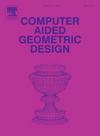增材制造自支撑结构的高效最坏情况拓扑优化
IF 1.7
4区 计算机科学
Q3 COMPUTER SCIENCE, SOFTWARE ENGINEERING
引用次数: 0
摘要
在最坏情况拓扑优化中,不确定的负载会导致复杂的内部结构和复杂的打印细节,从而挑战可制造性。然而,这些特性对制造性能的影响往往被忽视,可能会影响增材制造(AM)中最终产品的可打印性和质量。介绍了一种基于最坏情况拓扑优化生成三维自支撑结构的新方法。所提出的框架采用隐式张量-积b样条(ITPBS)表示,直接采用其系数作为设计变量,以最小化顺应性,同时强制实施自支持约束和最小长度尺度。通过重新制定增材制造约束,我们解析地推导出一个同时解决悬垂区域和滴水效应的单一几何制造约束。ITPBS提供的固-空边界表示可以将制造约束无缝集成到最坏情况优化过程中。通过求解特征值问题来评估最坏情况下的柔度,并采用伴随变量法进行灵敏度分析。数值实验表明,该方法能有效地生成跨多种模型的自支撑结构。本文章由计算机程序翻译,如有差异,请以英文原文为准。
Efficient worst-case topology optimization of self-supporting structures for additive manufacturing
In worst-case topology optimization, uncertain loads can result in complex internal structures and intricate printed details that challenge manufacturability. However, the impact of these features on manufacturing performance is often overlooked, potentially compromising the printability and quality of the final product in additive manufacturing (AM). This paper introduces a novel approach for generating 3D self-supporting structures under worst-case topology optimization. The proposed framework utilizes an implicit tensor-product B-spline (ITPBS) representation, directly adopting its coefficients as design variables to minimize compliance while enforcing self-supporting constraints and minimal length scale. By reformulating AM constraints, we analytically derive a single geometric fabrication constraint that simultaneously addresses both overhang regions and the dripping effect. The solid-void boundary representation provided by ITPBS enables seamless integration of fabrication constraints into the worst-case optimization process. Worst-case compliance is evaluated by solving an eigenvalue problem, and sensitivity analysis is conducted using the adjoint variable method. Numerical experiments demonstrate that the proposed approach effectively produces self-supporting structures across various models.
求助全文
通过发布文献求助,成功后即可免费获取论文全文。
去求助
来源期刊

Computer Aided Geometric Design
工程技术-计算机:软件工程
CiteScore
3.50
自引率
13.30%
发文量
57
审稿时长
60 days
期刊介绍:
The journal Computer Aided Geometric Design is for researchers, scholars, and software developers dealing with mathematical and computational methods for the description of geometric objects as they arise in areas ranging from CAD/CAM to robotics and scientific visualization. The journal publishes original research papers, survey papers and with quick editorial decisions short communications of at most 3 pages. The primary objects of interest are curves, surfaces, and volumes such as splines (NURBS), meshes, subdivision surfaces as well as algorithms to generate, analyze, and manipulate them. This journal will report on new developments in CAGD and its applications, including but not restricted to the following:
-Mathematical and Geometric Foundations-
Curve, Surface, and Volume generation-
CAGD applications in Numerical Analysis, Computational Geometry, Computer Graphics, or Computer Vision-
Industrial, medical, and scientific applications.
The aim is to collect and disseminate information on computer aided design in one journal. To provide the user community with methods and algorithms for representing curves and surfaces. To illustrate computer aided geometric design by means of interesting applications. To combine curve and surface methods with computer graphics. To explain scientific phenomena by means of computer graphics. To concentrate on the interaction between theory and application. To expose unsolved problems of the practice. To develop new methods in computer aided geometry.
 求助内容:
求助内容: 应助结果提醒方式:
应助结果提醒方式:


